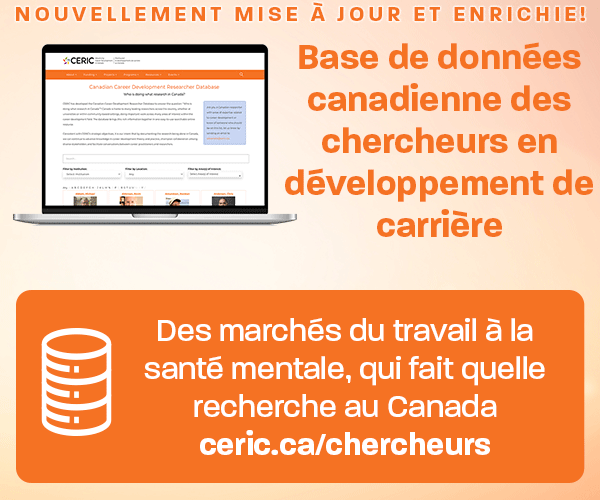Aider les jeunes à faire correspondre leurs compétences aux besoins actuels du marché du travail grâce au programme obligatoire d'études professionnelles de l'Ontario : Un examen des documents du curriculum.
Mots-clés :
jeunesse, compétences, ontario, études de carrière, curriculum, programmesRésumé
The Organisation for Economic Cooperation and Development (OECD) proposed that policies to address high youth unemployment should include better matching between the skills acquired at school and those needed in the labour market (OECD, 2011). This analysis, utilizing Cohen’s (2001) conceptual sense-making model, examined two guidance and career education documents to determine whether their expectations aligned with OECD policy priorities. One document contained a range of strategies for the meeting of program expectations. The other document provided more flexibility to align program expectations to meet OECD policies. A significant implication was the reliance on information technology (IT) to facilitate students to access current labour market information.
Références
Barrett, S., & Hill, M. (1984). Policy bargaining and structure in implementation theory: Towards an integrated perspective. Policy and Politics. 12(3), 219-240
Bezanson, M. L., & O’Reilly, E. (2002). Making waves: Volume 2. Connecting career development with public policy. Ottawa, ON: Canadian Career Development Foundation.
Coburn, C. E. (2001). Collective sense making about reading: How teachers mediate reading policy in their professional communities. Educational Evaluation and
Policy Analysis, 23(2), 145-170.
Coburn, C. E. (2005). The role of non system actors in the relationship between policy and practice: The case of reading instruction in California. Educational Evaluation and Policy Analysis, 27(1), 23-52.
Coburn, C. E., & Stein, M. K. (2006). Communities of practice theory and the role of teacher professional community in policy implementation. In M. I. Honig (Ed.), New directions in education policy implementation: Confronting complexity (pp. 25-46). Albany, NY: State University Press.
Dagley, J. C., & Salter, S. K. (2004). Practice and research in career counselling and development, 2003. Career Development Quarterly, 53(2), 98-157.
Downey, L. W. (1998). Policy analysis in education. Calgary, AB: Detselig Enterprises.
Dunbar, D, Jr., & Villarruel, F. A. (2002). Urban school leaders and the implementation of zero-tolerance policies: An examination of its implications. Peabody Journal of Education. 77(1), 82-104.
Hutchinson, N. L., Munby, H., Chin, P., Edwards, K. L., Steiner-Bell, K., Chapman, C., Ho, K., & Mills de España, W. (2001). The intended curriculum in co-operative
education in Ontario secondary schools: An analysis of school district documents. Journal of Vocational Educational Research, 26, 103-140.
Lalande, V., & Magnusson, K. (2007). Measuring the impact of career development services in Canada: Current and preferred practices. Canadian Journal of Counselling. 41(3), 133-145.
Larsson, M., Segersteen, S., & Svensson, C. (2011). Information and informality: Leaders as knowledge brokers in a high tech firm. Journal of Leadership & Organizational Studies, 18(2), 175-191.
Magnusson, K., & Roest, A. (2004). The efficacy of career development interventions: A synthesis of research. Retrieved from http://www.iaevg.org/crc/files/magnusson-CareerEfficacysynthesis829_2d.
Matland, R. E. (1995). Synthesizing the implementation literature: The ambiguity-conflict model of policy implementation. Journal of Public Administration Research and Theory. 5(2), 145-177.
McLaughlin, M. W. (1987). Learning from experience: Lessons from policy implementation. Educational Evaluation and Policy Analyses. 9(2), 171-178.
Nixon, J. (1980). The importance of communication in the implementation of government policy at local level. Policy and Politics. 8(2), 127-144.
Ontario Ministry of Education. (1998). Choices into action: Guidance and career education policy grades 1 to 12 (1998), detailed discussion document. Retrieved from
http://www.edu.gov.on.ca/eng/document/discussi/choices.pdf.
Ontario Ministry of Education. (2006). The Ontario curriculum grades 9 and 10. Guidance and Career Education. (revised 2006). Retrieved from http://www.edu.gov.on.ca/eng/curriculum/secondary/guidance.html.
Organisation for Economic CoOperation and Development (OECD). (2011). Employment outlook 2011: Multilingual Summaries. Paris, FR: OECD.
Organisation for Economic CoOperation and Development (OECD). (2010). Off to a good start? Jobs for youth. Paris, FR: OECD.
Robitaille, D. F., Schmidt, W. H., Raizen, S., McKnight, C., Briton, E., & Nicol, C. (1993). Curriculum frameworks for mathematics and science (Third International Mathematics and Science Study, Monograph #1). Vancouver, BC: Pacific Educational Press.
Sabatier, P. A. (1993). Policy change over a decade of move. In Sabatier, P. A. and Jenkin-Smith, H. C. (Eds.), Policy change and learning: An advocacy coalition approach. Boulder, CO: Westview Press.
Scheirer, M. A., & Griffith, J. (1990). Studying micro-implementation empirically: lessons and dilemmas. In D. J. Palumbo & D. J. Calista, (Eds.), Implementation and
the policy process: Opening up the black box. New York, NY: Greenwood Press.
Schofield, J. (2001). Time for a revival? Public policy implementation” A review of the literature and an agenda for future research. International Journal of Management Reviews. 3(3), 245-263.
Slomp, M. W., Bernes, K. B., & Magnusson, K. C. (2011). Evaluating the impact of career development services in Canada: The perceptions of managers and program administrators. Canadian Journal of Career Development. 10(1), 5-12.
Spillane, J. P., Diamond, J. B., Burch, P., Hallett, T., Jita, L., & Zoltners, J. (2002). Managing in the middle: School leaders and the enactment of accountability policy. Educational Policy. 16(5), 731-762.
Spillane, J. P. (2000). Cognition and policy implementation: District policymakers and the reform of mathematics education. Cognition and Instruction. 18, 141-179
Taylor, A. (2007). Pathways for youth to the labour market: Canadian Policy Research Networks project. Ottawa, Canadian Council for Learning: Work and Learning Knowledge Centre: Ottawa.
Versnel, J., DeLuca, C., Hutchinson, N., Hill, A., & Chin, P. (2011). International and national factors affecting school-to-work transition for at-risk youth in Canada: An
integrative review. Canadian Journal of Career Development. 10(1), 21-31.
Weick, K. E., (1995). Sensemaking in organizations. Thousand Oaks, CA: Sage Publications.
Yin, R. K. (1982). Studying the implementation of public programs. In W. Williams, (Ed.), Studying implementation: Methodological and administrative assues. Chatham, NH: Chatham House.

Téléchargements
Publié-e
Comment citer
Numéro
Rubrique
Licence

Cette œuvre est sous licence Creative Commons Attribution - Pas d'Utilisation Commerciale - Pas de Modification 4.0 International.











